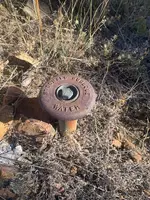cuts
Tenderfoot
My detecting journey began in 2003 when I rented an ACE 150 to help locate the curb-stop water shut-off valve to my in-law's townhouse on a cold snowy March afternoon in mid-central Minnesota.
Fast forward to 20-some years, my refined detecting skills have led to astonishing discoveries including coins, jewelry, bottles, pendants, just about anything imaginable. Along the way, I have stumbled upon a repeatable signal, one we've all encountered - Bottlecaps.
Now, my observation applies strictly to the behavior of an Equinox 800 with 11" Double D Coil and 6" Sniper Coil. If properly balanced, ground conditions do not seem to affect what I have experienced. This means wet or dry soil, light or heavy loam (including sand), low or highly mineralized.
I am using the curb stop as reference point on purpose. As with most bottlecaps, and not like any nickel, caps have a rounded corner on one side and an open cavity on the other. Now that inside cavity is usually fluted so as to create the compression seal. By contrast, nickels are solid or concentric side to side, often with their square edge intact.
The VDI for nickels is 13 on a Nox 800.
When swinging over the target, whether left to right or vice-versa, the discernment is at this end of the swing. Once your ears are "a-tuned," (new word), a bottlecap gives off a very light "thud" at the end of the swing - whether the cap is up, down or at angle. I believe this is due to the processor identifying the iron since the bulk of the swing is identifying the profile. Even with iron audio, the Nox 800 cannot discern between bottlecap or nickel - it requires the operator's discernment.
Of course, everyone has their own interpretation of how their detector detects. My experience is based on digging what could be the largest bottlecap collection known to exist. Since identifying this "thud" behavior over the past several years, nickel recoveries now outpace bottlecaps nearly 100%.
Hope this help you!
Cuts
Fast forward to 20-some years, my refined detecting skills have led to astonishing discoveries including coins, jewelry, bottles, pendants, just about anything imaginable. Along the way, I have stumbled upon a repeatable signal, one we've all encountered - Bottlecaps.
Now, my observation applies strictly to the behavior of an Equinox 800 with 11" Double D Coil and 6" Sniper Coil. If properly balanced, ground conditions do not seem to affect what I have experienced. This means wet or dry soil, light or heavy loam (including sand), low or highly mineralized.
I am using the curb stop as reference point on purpose. As with most bottlecaps, and not like any nickel, caps have a rounded corner on one side and an open cavity on the other. Now that inside cavity is usually fluted so as to create the compression seal. By contrast, nickels are solid or concentric side to side, often with their square edge intact.
The VDI for nickels is 13 on a Nox 800.
When swinging over the target, whether left to right or vice-versa, the discernment is at this end of the swing. Once your ears are "a-tuned," (new word), a bottlecap gives off a very light "thud" at the end of the swing - whether the cap is up, down or at angle. I believe this is due to the processor identifying the iron since the bulk of the swing is identifying the profile. Even with iron audio, the Nox 800 cannot discern between bottlecap or nickel - it requires the operator's discernment.
Of course, everyone has their own interpretation of how their detector detects. My experience is based on digging what could be the largest bottlecap collection known to exist. Since identifying this "thud" behavior over the past several years, nickel recoveries now outpace bottlecaps nearly 100%.
Hope this help you!
Cuts
Attachments
Upvote
1




